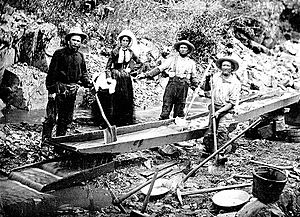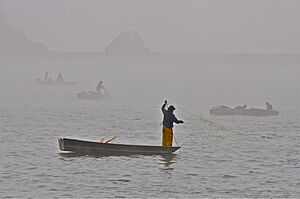Un-Dam the Klamath facts for kids
The Un-Dam the Klamath movement is a group of people working to remove dams on the Klamath River in the United States. The main reason for this movement is that the dams block fish like salmon and steelhead from reaching their natural homes upstream. This area has hundreds of miles of places where fish can lay their eggs.
These dams have also greatly harmed the way of life for the Hupa, Karuk, Klamath, and Yurok Native American communities. Four dams are targeted for removal: Copco #1, Copco #2, Iron Gate (all in California), and J.C. Boyle (in Oregon). These dams are used to create electricity from water.
The movement to remove the dams has been active for over 20 years. It gained a lot of attention after a big event in 2002. At least 33,000 salmon and steelhead fish died along the riverbanks. This happened because they couldn't reach their spawning grounds upstream.
People in the movement say the dams should be removed because they cause harmful algae blooms. They also make salmon numbers drop and cause fish to get sick. The dams threaten the traditional ways of getting food for tribes and increase health risks for tribal members. They also hurt the fishing industry on the West Coast. Removing the dams would also be good for the economy.
Some groups are against removing the dams. These include landowners who live near the lakes created by the dams. Companies like PacifiCorp, owned by Warren Buffett, were also against it. PacifiCorp first agreed to remove the dams in 2009. But after ten years of talks, they backed out. This happened when the Federal Energy Regulatory Commission (FERC) said PacifiCorp should pay for the removal.
Supporters of dam removal say that issues like environmental racism and classism are why the dams are still there. Removing these dams would be the biggest dam removal project in the world. It would help fish get back to their natural, cold-water homes.
Contents
Why the Dams Were Built

The Hupa, Karuk, Klamath, and Yurok tribes have fished along the Klamath River for thousands of years. When settlers came to the region during the California Gold Rush, they started logging and mining without control. This destroyed places where salmon laid their eggs. Many Native Americans were killed or forced from their homes.
By 1855, it was reported that many Yurok people had died from settler violence or disease. Those who survived were moved to small reservations. They were separated from most of their lands. By the 1870s, the number of all Native American people on the Klamath River had dropped by 75 percent. Later, in the late 1800s, Native American children were forced to go to boarding schools. This further harmed their cultures and ways of thinking.
In 1906, the first canal of the Klamath Irrigation Project was finished. Building of Copco #1 and #2 dams began in 1918 and finished soon after. By the 1930s, the irrigation project had caused salmon to almost disappear. Because of this, commercial fishing and fishing by Yurok tribal members were banned. The completion of the J.C. Boyle (1958) and Iron Gate Dam (1964) further damaged Native American ways of life. Ron Reed, a member of the Karuk Tribe, remembered that the river was a source of food for his family until the last dam, Iron Gate, was completed in the 1960s.
In 1978, the Supreme Court of California supported the ban on fishing for tribes. The Yurok had been fighting to get their fishing rights back since the 1930s. This decision led to protests from the tribe. Federal agents and police used force against tribal members between 1978 and 1979. In one case, Yurok people were celebrating a birthday near the river when agents arrived and used their clubs. In 1979, the Supreme Court said that tribes should get 50 percent of the fish they could catch. It also said they should help manage state fisheries. This ended the conflict. In the 1980s, too much logging by settlers caused game animals, acorns, and other foods to become scarce or disappear.
The dams caused a big drop in Native American fishing. This meant that Native families had to eat more store-bought foods. These foods were often cheap starches, fats, and sugar. As the river's life disappeared, problems like long-term unemployment and sadness grew. Diana Hartel, who studies how settlers and dams harmed Native American health, explained this. She said that the loss of Native fisheries led to more poverty and higher rates of diabetes. Hartel believes that because settlers are "disconnected from life rhythms millions of years old," they can cause great harm to nature.
Efforts to Remove the Dams
The remaining water left in the river... is so little in volume, so hot and so laced with pesticides and nitrates from agricultural waste water that it is often fatal for salmon... Hundreds of thousands of salmon have been killed in recent years...
Asking for New Licenses
The 2002 Klamath River fish kill was a very important event. At least 33,000 fish died, and some say it was over 70,000. This event helped gain support for dam removal. It also helped stop companies from getting new licenses for the dams. Craig Tucker, a consultant for the Karuk tribe, said that the fish kill happened around the same time the dam licenses were ending. He said it "put an exclamation point on the need for removing the dams." The U.S. Fish and Wildlife Service said that water being sent to farmers and ranchers in the Klamath Basin caused the fish kill. This was approved by then Vice President Dick Cheney. Cheney was later investigated for his role in this event.
In 2005, PacifiCorp asked the government for new licenses for the four dams. This would have let them operate the dams for another 50 years. Environmental groups, tribal groups, and other supporters were against this.
Early requests to Warren Buffett by movement groups to stop the new licenses were turned down. In one case, Merv George Jr. (Hupa) and his wife, Wendy, traveled to Buffett's office. Wendy spoke to an image of Buffett on a large screen. She said, "Sir, I have heard you are kind. The dams are killing the fish and destroying my people's way of life." Buffett then explained how utility companies work. Forbes Magazine reportedly "wondered how he could be so heartless."
At a meeting in October 2008, it was noted that fish like Coho, chinook, steelhead, Pacific lamprey, and green sturgeon could disappear forever if the dams stayed. Diana Hartel said that groups against dam removal did not listen to Native American people. She said they were "proud of their place in the West and sadly ignorant of the plight of the tribes on the river." In 2011, Hartel wrote that their arguments were about "settler pride of place." They felt proud of taking a wild river and making it "useful" for cheap power and farming.
The process of PacifiCorp getting new licenses for the dams stopped in 2009. This was because the company decided that "the dams were too expensive to fix."
Working Towards an Agreement
On February 19, 2010, many groups signed the Klamath Basin Restoration Agreement (KBRA). These groups included Ken Salazar, representatives from PacifiCorp, and governors from Oregon and California.
On April 4, 2013, the U.S. Department of the Interior said that the four dams should be removed. They also said that $1 billion would be used to help restore the river and native salmon. Ron Wyden, a U.S. senator from Oregon, introduced a bill in 2014 to help with this.
On February 8, 2017, a federal judge ruled that the dams should be removed. The judge agreed with a plan from tribal scientists. This plan would help reduce fish diseases. Between 2014 and 2015, 90% of young salmon were reportedly sick.
The U.S. Congress did not pass the law needed to make the KBRA happen by January 1, 2016. This meant a new agreement had to be made. So, the Klamath Hydroelectric Settlement Agreement (KHSA) was signed on April 6, 2016. This new agreement created the Klamath River Renewal Corporation (KRRC). This group would now ask to take over the dam licenses from PacifiCorp.
In April 2020, the California Water Board approved two important permits for removing the dams. The board decided that removing the dams would make drinking water better by reducing algae. It would also restore homes for salmon and other creatures that need free-flowing rivers. However, the project still needed approval from the Federal Energy Regulatory Commission (FERC).
On July 17, 2020, FERC said that PacifiCorp would have to stay involved during the dam removal. This was different from what KRRC and PacifiCorp had agreed on earlier. FERC said PacifiCorp would need to be responsible for any extra costs. Because of this, PacifiCorp pulled out of the agreement. This slowed down the dam removal process again.
On October 22, 2020, the movement was featured in a video story by Vice News. The video reported that after ten years of talks, the Yurok tribe wondered if the dams would ever really be removed. Salmon numbers were at their lowest ever. Yurok tribal members explained that the salmon could not survive much longer.
As of February 25, 2022, FERC released their final Environmental Impact Statement. The four dams are expected to be removed sometime in 2023 or 2024.



